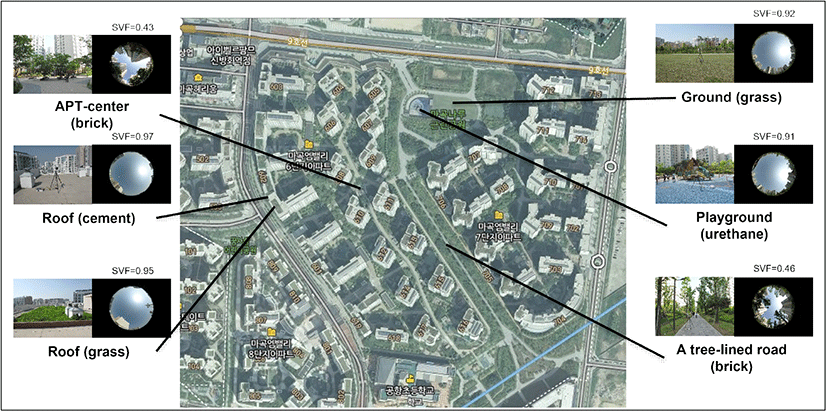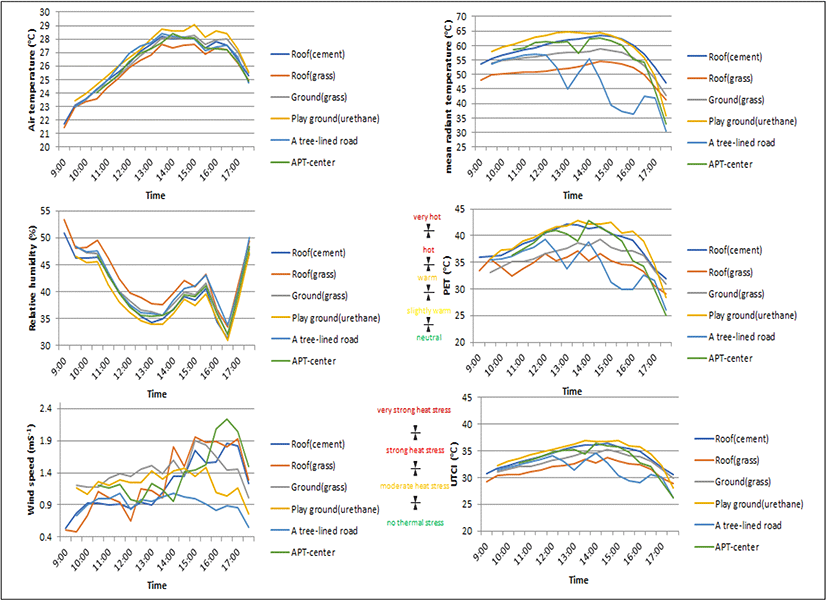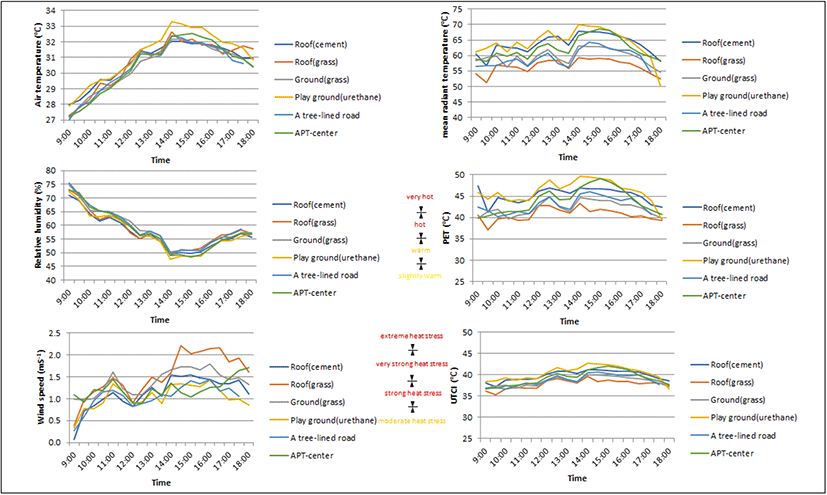Ⅰ. 서론
2018년 여름철은 기상관측 111년만에 최고 높은 기온을 기록했다(Korea Meteorological Administration, 2018). 서울의 낮 기온은 39.6°C, 밤 기온은 30.3°C로 1994년 7월 24일 38.4°C보다 1.2°C 높게 나타났다. 이러한 영향으로 수도권 지역의 폭염일수와 열대야일수가 증가하면서 열질환자수가 증가하고, 열환경적으로 도시민의 삶의 질은 떨어지고 있다. 국립환경과학원 보도자료에 따르면, 폭염주의보가 발생했던 2018년 7월 19~20일과 폭염경보가 발생했던 8월 2~3일 수원시 호매실 택지개발지구 열환경 측정 9지점에서 산림을 제외한 모든 그린 및 그레이 인프라에서 physiological equivalent temperature(PET; Höppe, 1999) 기준으로 매우 심한 열스트레스를 받는다는 연구결과가 나왔다(Ministry of Environment, 2018). 이러한 도시 열환경 악화로 인해 도시의 미기후요소(기온, 습도, 풍속, 태양 및 지구 복사에너지)와 인간 열환경지수 또는 열쾌적성을 예측하는 연구가 전 세계적으로 진행되고 있다.
인간 열환경에 대한 연구는 크게 실측자료를 측정한 연구와 컴퓨터 시뮬레이션 프로그램을 이용하여 열저감 효과를 비교분석한 연구로 나눌 수 있다. 실측을 통한 연구로는 그린 인프라[지피식물, 수목, 수(水)공간]의 요소별 열저감 효과와 인공 구조물을 포함한 공간구조별 열환경 비교분석에 대한 연구로 나눌 수 있다. 그린 인프라인 독립수(Ju et al., 2004; Choi and Lee, 2006; Shahidan et al., 2010; Égerházi et al., 2013; Lee and Ryu, 2014; Abreu-Harbich et al., 2015; Takács et al., 2016), 가로수(Park, 2013; Abreu-Harbich et al., 2015; Jo et al., 2017), 공원과 녹지(Yoon, 2003; Lee and Ryu, 2012; Park, 2013; Yoon et al., 2014; Ryu and Lee, 2015; Park et al., 2017), 수공간(Han and Huh, 2006)에 대한 다양한 연구들이 있었으며, 인공 구조물을 포함한 공간구조별 열환경에 대한 연구로는 포장재료(Lee and Ryu, 2010; Park, 2013), 차양재료(Lee and Ryu, 2013), 공원과 다른 용도지구 비교(Bowler et al., 2010; Chow et al., 2011; Kim et al., 2016; Park et al., 2017) 연구들이 있었다. 최근에는 지역기후구역(local climate zone, LCZ; Stewart and Oke, 2012)을 이용하여 도시 내 용도지구를 건축물 형태(built type) 10종류, 지표면 종류(land cover type) 7종류, 지표면 속성(land cover property) 4종류로 분류하여 도시 열환경을 분석하는 연구가 새롭게 진행되고 있다(Kim and Eum, 2017; Kong et al., 2018, 2020).
컴퓨터 시뮬레이션 프로그램을 이용한 연구는 전 세계적으로 2006~2019년까지 130편에 이르며 매우 활발히 진행되고 있는 것으로 나타났다(Lam et al., 2021). 국내에서는 실측자료 없이 ENVI-met만을 이용하여 아파트 주동형태 및 배치에 따른 기온과 풍속의 변화를 알아본 연구(Kim et al., 2009), 컴퓨터 시뮬레이션의 정확성을 알아보기 위해 기존 도시지역의 포장재료에 따른 열환경 실측자료와 ENVI-met 모델의 결과값을 비교한 연구(Song et al., 2014), 경상남도 창원에 위치한 대학 캠퍼스 14개 지점의 실측 PET와 ENVI-met의 PET를 비교해 본 연구(Jeong et al., 2016), 캐나다 나나이모시와 대한민국 창원시의 도시를 대상으로 human urban radiation exchange simulation(HURES; Park, 2011)과 ENVI-met을 이용하여 universal thermal climate index(UTCI; Bröde et al., 2012a, 2012b; http://www.utci.org)를 분석하고, 인간 생명기후지도(human bioclimatic map)를 만든 연구(Park et al., 2014) 등이 있었다.
기존의 도시공간에 조경적 요소인 자연적 요소와 인공적 요소를 추가 및 변형하여 가상의 시나리오별 설정을 통한 열환경 변화를 분석한 연구들이 있었다. 자연적 요소인 초본, 관목, 교목의 수종과 식재유형을 다르게 하여 공동주택 단지 내 열환경 저감 효과를 살펴본 연구(Moon and Jang, 2012), 기존 도시 저층주거지역에 옥상녹화를 조성할 경우, 풍속의 변화에 따른 주변 기온의 저감효과 범위를 알아본 연구(Kim et al., 2013), 기존 아파트 단지 내에 수경공간을 조성하여 기온과 풍속의 변화를 살펴본 연구(Park et al., 2011), 하천복원사업으로 복원 전과 후의 대상지 기온변화를 살펴본 연구(Jeong, 2012), 복개하천 주차장의 피복 및 식재 변화 시나리오를 ENVI-met을 이용해 열환경 및 열쾌적성을 분석한 연구(Kim and Kim, 2020) 등이 있었다. 그러나, 컴퓨터 시뮬레이션 결과는 반드시 실측자료와의 비교를 통한 신뢰성 검증을 거쳐야 할 것이다. 특히, 인간 열환경지수 및 열쾌적성 분석에서는 기온뿐만 아니라 상대습도, 풍속, 태양·지구복사에너지를 이용해 계산된 평균복사온도에 대해서도 반드시 검증을 거쳐야 하며, 컴퓨터 시뮬레이션 결과는 각각의 미기후 요소들의 보정식을 통해 재계산된 값들을 이용하여야 할 것이다(Lam et al., 2021).
우리나라 가구 전체의 51.5%인 942만 가구가 살고 있는(Statistics Korea, 2020) 아파트 옥외 열환경에 대한 실측을 통한 연구는 거의 이루어지지 않아서, 컴퓨터 시뮬레이션을 이용한 다양한 열환경 분석에 대한 비교검증 자료가 전무한 실정이다. 이에 본 연구에서는 아파트 단지 내의 대표적인 지표면 종류 및 속성 지점들의 미기후 자료들을 실측하고, 인간 열환경지수를 분석하여, 아파트 단지에 대한 조경계획 및 설계 시 쾌적한 열환경 조성을 위한 방법을 찾아보고자 한다.
Ⅱ. 연구방법
2014년에 준공된 서울특별시 강서구 마곡서1로 100 마곡엠밸리 6단지 아파트에서 2018년 늦봄 5월 26일, 여름철 7월 18일 9:00~18:00까지 아파트 중심(APT-center, 블럭포장), 아파트옥상 2지점(roof 시멘트포장, roof 잔디포장), 운동장(ground, 잔디포장), 어린이놀이터(playground, 우레탄포장), 가로수길(a tree-lined road, 블럭포장) 총 6지점에서 미기후 자료를 측정하였다(Figure 1 참조). 측정 날짜는 지점별 열환경 차이가 가장 크게 나타나는 맑은 날로 선정하여, 늦봄과 폭염기간을 제외한 여름철 기간 중 열환경이 가장 높게 나오는 환경이다. 폭염기간을 임의로 제외한 것은 아니며, 맑은 날을 기준으로 측정 날짜를 선정하는 한계에 의해 포함시키지 못 하였다. 향후, 폭염기간의 열환경에 대해서도 연구되어야 할 것이다.

위 아파트 지역은 판상형과 탑상형 아파트 배치 형태 중 최근에 많이 건축하는 탑상형으로 조성되어 있다(Bae and Ha, 2019). 지점선정은 아파트 단지 내의 대표적인 지표면 종류 및 속성 지점들을 대상으로, 아파트 거주민들이 가장 많이 이용하는 공간 4지점과 옥상녹화 효과를 확인하기 위한 2지점으로 하였다. 아파트중심지점은 16층의 아파트 건물이 46m의 동간 간격으로 둘러싸인 곳으로, 전체적으로 블럭포장이 되어 있으며, 수고 6m의 느티나무(Zelkova serrata)와 화강석 벤치가 중심부 근처에 배치되어 있었다. 아파트옥상지점은 140m2 면적의 잔디지점과 시멘트포장지점으로 나뉘어진다. 잔디상태는 15~20cm 내외로 피복되어 있었으나 관리가 잘 되어 있지는 않았다. 운동장지점은 잔디포장이며, 면적이 1,680m2로 잘 관리되었다. 어린이놀이터지점은 우레탄포장으로 면적이 507m2였으며, 미끄럼틀집, 시소, 짚라인(zip line)이 설치되어 있었다. 가로수길 지점은 블럭포장으로 되어 있으며, 자전거로, 산책로로 이용되고 있었고, 보도폭 4m, 거리 247m, 좌우로 식수대폭이 12m, 14m로 다양한 교목과 관목이 식재되어 있었으며 잔디로 피복되어 있었다. 가로수는 메타세콰이어(Metasequoia glyptostroboides)로 수고가 12m 정도 되었다.
측정된 미기후 요소들은 기온, 상대습도, 풍속과 풍향, 태양 및 지구복사에너지로서 양지에서 지상 1.2m 높이에서 측정하였다. 그러나, 봄철 아파트중심(APT-center)지점과 가로수길(a tree-lined road)지점은 오후시간대에 건물과 수목 그늘의 영향으로 음지에 위치하기도 하여, 13:00 이전의 양지에서 측정된 자료를 기준으로 비교하였다. 태양 및 지구복사에너지는 CNR4 net-radiometer(Kipp & Zonen Inc.)를 이용하여 5초 단위로 자료를 측정하였고, 기온과 상대습도는 HMP155A (Campbell Scientific Inc.), 풍속과 풍향은 Met-one 034B-L Windset(Campbell Scientific Inc.)을 이용하여 1분 단위로 자료를 측정하였다(Table 1 참조).
평균복사온도는 측정된 태양 및 지구복사에너지를 이용하여 Park(2011)과 Lee et al.(2021)의 방법으로 계산되었다. 인간 열환경지수는 전 세계적으로 옥외공간에서 가장 많이 이용되고 있는 PET와 UTCI를 분석하였으며(Lam et al., 2021), 측정된 미기후 자료인 기온, 상대습도, 풍속과 계산된 평균복사온도 자료를 RayMan Pro. Ver. 2.2(Matzarakis et al., 2010; http://www.urbanclimate.net/rayman)에 입력하여 계산되었다(Table 2 참조).
통계분석은 미기후 자료와 인간 열환경지수인 PET, UTCI의 30분 평균자료를 이용하여 SPSS Ver. 24의 One-way ANOVA Duncan 분석을 수행하여, 지점 간의 유의성 검증을 실시하였다.
Ⅲ. 연구결과 및 고찰
늦봄 기온은 우레탄포장으로 된 어린이놀이터지점이 평균 27.4°C로 가장 높게 나타나, 가장 낮게 나타난 옥상(녹화)지점의 평균 26.3°C에 비해 평균 1.1°C 높은 것으로 나타났다(Figure 2, Table 3 참조). 두 지점을 제외한 나머지 4지점에서는 평균 0.2°C의 미미한 차이를 보였다. 상대습도는 식물이 식재된 옥상(녹화)지점, 운동장지점, 가로수길 지점들이 가장 낮게 나온 어린이놀이터지점보다 최대 평균 4% 정도 높게 나타났으며, 옥상(시멘트)지점과 아파트중심지점에 비해서는 평균 1~2% 높게 나타났으나 큰 차이는 없는 것으로 보인다. 풍속 은 평균 0.9 ms−1을 보인 가로수길 지점을 제외한 다른 지점들은 1.3~1.5 ms−1로 나와, 가로수길에 식재된 수목의 풍속저감 영향이 있는 것으로 보인다. 다만, 아파트중심지점이 오후시간으로 갈수록 풍속이 급격히 높아지는 것은 아파트 건물에 의해 발생되는 빌딩풍의 영향이 있는 것으로 보인다.

평균복사온도에서는 옥상(녹화)지점이 가장 낮은 평균 51°C를 나타내었으며, 어린이놀이터지점과 옥상(시멘트)지점이 가장 높은 평균 59~60°C를 보여, 평균 차이 값이 약 8°C로 나타났다. 또한, 어린이놀이터지점이 옥상(녹화)지점에 비해 12:35분에 최대 13.7°C 높게 나타났다. 운동장지점은 잔디의 영향으로 평균 55.2°C를 보였으며, 아파트중심지점은 건물의 높이와 동 간 좁은 간격의 영향으로 발생한 주변 음지의 영향으로 평균 56.8°C를 보였다. 오후에 가장 낮게 나온 가로수길 지점은 건물과 수목에 의해 발생한 음지에 위치한 결과이다.
여름철에도 기온은 봄철과 같이 어린이놀이터지점이 가장 높게(평균 31.8°C) 나타났으며, 다른 지점들은 평균 31.0~31.3°C로 차이가 0.5~0.8°C로 나타나, 늦봄보다는 적은 차이를 보였다(Figure 3, Table 3 참조). 상대습도도 식물이 있는 세 지점들에서 다른 지점들에 비해 최대 1.8%의 미미한 차이를 보였다. 풍속도 오후로 갈수록 강해졌으며, 특히 오픈스페이스인 옥상(녹화)지점(평균 1.7 ms−1)과 운동장지점(평균 1.5 ms−1)에서 가장 큰 변화를 볼 수 있었다. 다른 지점들은 평균 1.1~1.3 ms−1로 다소 낮은 결과를 보였다. 평균복사온도에서는 어린이놀이터지점(평균 64.6°C), 옥상(시멘트)지점(평균 64.5°C), 아파트중심지점(평균 63.1°C)이 다른 세 지점들보다 평균 6.0~7.5°C 높게 나타났다. 특히, 옥상(녹화)지점은 옥상(시멘트)지점에 비해 7.4°C 낮은 저감효과를 보여 주었다.

One-way ANOVA의 Duncan 분석 결과, 기온과 상대습도는 늦봄과 여름철 모든 지점에서 유의성이 없는 것으로 나타났다(Table 3 참조). 풍속에서는 늦봄에는 가로수길 지점만 다른 지점과 유의성이 있었으며, 여름철에는 풍속이 낮게 나온 어린이놀이터지점·가로수길 지점·옥상(시멘트)지점·아파트중심지점 간에 유의성이 없는 것으로 나타났다. 평균복사온도에서는 크게 그린인프라 지점들인 옥상(녹화)지점·가로수길 지점·운동장지점과 아닌 지점들로 구분되었다.
늦봄, 인간 열환경지수인 PET에서는 대부분의 지점들이 ‘더움(hot)’ 단계의 열환경지수를 나타내었으며, 어린이놀이터지점, 옥상(시멘트)지점, 아파트중심지점은 12:00~15:00 사이에 ‘매우 더움(very hot)’ 단계를 보였다(Figure 2 참조). 평균적으로는 옥상(녹화)지점에서 가장 낮은 평균 34.4°C로 나타나, 옥상(시멘트)지점에 비해서는 평균 4.6°C 저감 효과를 보였으며, 가장 높게 나타난 어린이놀이터지점에 비해서는 평균 5.2°C 저감 효과를 보였다. 운동장지점과 아파트중심지점은 각각 잔디와 그늘의 영향으로 평균 36.4°C, 37.4°C를 나타냈다. 어린이놀이터지점과 옥상(녹화)지점의 최대 차이는 평균복사온도와 동일하게 12:35분에 11.7°C 차이를 보였다.
UTCI에서도 PET의 결과와 유사하게 대부분의 지점들이 ‘강한 열스트레스(strong heat stress)’ 단계를 보였다. 옥상녹화의 열저감 효과는 평균 2.5°C인 것으로 나타났으며, 가장 높았던 어린이놀이터지점에 비해서는 3.0°C 저감 효과를 보여 주었다. 두 지점간 최대 차이는 평균복사온도와 PET에서 최고 차이를 보였던 시간보다 더 늦은 14:11분에 6.1°C 차이를 보였다.
여름철에는 PET에서 모든 지점들이 평균 41.0°C를 넘어 ‘매우 더움(very hot)’으로 나타났다(Figure 3 참조). 그 중 어린이놀이터지점이 가장 높은 평균 46.5°C를 나타내었으며, 옥상(시멘트)지점이 두 번째로 높은 평균 45.5°C를 나타내었다. 가장 낮게 나온 옥상(녹화)지점(평균 41.1°C)은 옥상(시멘트)지점에 비해 평균 4.4°C, 가장 높게 나온 어린이놀이터지점에 비해 평균 5.4°C 낮은 열저감 효과를 보여 주었으며, 최대 차이는 15:05에 어린이놀이터지점과 18.1°C의 차이를 보여 주었다. 운동장지점과 가로수길 지점도 어린이놀이터지점에 비해서는 평균 3.9°C 낮은 결과를 보여 주었다.
UTCI에서도 PET와 유사하게 오전에는 ‘강한 열스트레스(strong heat stress)’ 단계를 보였으며, 12:00부터는 ‘매우 강한 열스트레스(very strong heat stress)’를 보였다. 가장 낮게 나온 옥상(녹화)지점(평균 38.2°C)이 옥상(시멘트)지점에 비해 평균 2.0°C, 가장 높게 나온 어린이놀이터지점에 비해 평균 2.6°C 낮은 열저감 효과를 보여 주었으며, 최대 차이는 16:30에 어린이놀이터지점과 9.8°C의 차이를 보였다. 운동장지점과 가로수길 지점도 어린이놀이터지점에 비해서는 평균 2.0°C 낮게 나왔다.
그러므로, 옥상녹화는 평균적으로 늦봄 4.6°C PET와 2.5°C UTCI, 여름철 4.4°C PET와 2.0°C UTCI 저감 효과를 나타내, PET에서는 2/3단계, UTCI에서는 1/3단계를 낮추는 결과를 보여 주었다. 지점 간 가장 높은 열환경을 보인 어린이놀이터지점과 가장 낮게 나온 옥상(녹화)지점 간의 차이도 평균적으로 늦봄 5.2°C PET와 3.0°C UTCI, 여름철 5.4°C PET와 2.6°C UTCI 저감 효과를 보여, PET에서는 거의 1단계, UTCI에서는 1/2단계의 차이를 보여 주었다. 또한, 두 지점 간 최대 차이는 늦봄 11.7°C PET와 6.1°C UTCI, 여름철 18.1°C PET와 9.8°C UTCI로 나타나, PET에서는 2~3단계의 매우 큰 차이를 보였으며, UTCI에서는 1~1.5단계의 큰 차이를 보였다. One-way ANOVA의 Duncan 분석 결과, 평균복사온도와 동일하게 그린인프라 3지점들과 아닌 지점들로 유의성이 크게 구분되는 결과를 보였다.
아파트 지역에서도 인간 열환경은 지표면 재질에 의한 영향을 뚜렷이 보여 주었다. 우레탄 포장으로 된 어린이놀이터지점이 가장 높은 열환경을 보여 주었으며, 옥상녹화가 된 지점에 비해 여름철 낮 시간대에 평균복사온도와 PET에서 각각 평균 7.5°C와 5.4°C 높은 결과를 보였다. 이것은 Kong et al. (2021)의 수원시 근린공원 연구에서 폴리우레탄 포장지점이 다른 재질에 비해서 매우 높은 평균복사온도와 PET 값을 보여 주었다는 결과와 동일하며, 잔디포장에 비해 각각 5.7°C와 3.2°C 높게 나온 결과보다는 조금 더 높은 결과를 보여 주었다. 본 연구의 잔디포장인 운동장지점이 어린이놀이터지점보다 각각 평균 4.7°C 평균복사온도와 3.9°C PET 낮게 나온 결과와는 유사하였다. 그러므로, 포장재료 선정에 좀 더 신중을 기할 필요가 있다. 물론, 블럭포장이지만 잔디포장인 운동장지점과 동일한 여름철 3.9°C PET 저감 효과를 보인 가로수길 지점은 주변 식수대와 가로수의 영향으로 평균복사온도는 운동장지점보다 1.7°C 더 낮은 결과를 보여, 식재효과 또한 포장재료의 영향보다 적다고 할 수 없을 것이다.
기후변화의 영향으로 여름철의 기간이 더 길어짐으로 인해 늦봄에도 매우 더운 열환경이 발생되는 것으로 나타났다. 특히, 늦봄의 가장 높은 열환경이 PET에서는 12:35, UTCI에서는 14:11에 나타나는 것에 비해, 여름철에는 PET에서는 15:05, UTCI에서는 16:20에 나타나므로, 수목 식재 시 그늘 효과의 최대치를 유도하기 위해, 식재될 수목의 수고, 수관폭, 지하고, 식재간격을 고려한 공간이용용도에 맞춘 계절별 식재 및 관리방안을 마련하여 쾌적한 열환경을 조성하여야 할 것이다.
아파트 외부공간의 열환경에 대한 컴퓨터 시뮬레이션을 이용한 연구는 많이 이루어졌으나, 실측 자료를 측정한 연구는 기온을 실측하여 비교한 연구(Kim et al., 2010)가 유일하여 축적된 자료가 없으므로, 다양한 지역에서의 자료 구축을 통한 조경계획 및 설계 방안 마련을 위한 노력이 더 필요할 것이다.
Ⅳ. 결론
서울특별시 강서구 마곡동에 위치한 엠벨리 6차 아파트 단지를 대상으로 늦봄과 여름철에 6지점[옥상(녹화)지점, 옥상(시멘트)지점, 아파트중심지점, 가로수길 지점, 어린이놀이터지점, 운동장지점]에서 미기후 자료(기온, 상대습도, 풍속, 태양·지구 복사에너지)를 측정하여 인간 열환경지수를 분석하여 보았다.
늦봄과 여름철 모두 어린이놀이터지점에서 가장 높은 열환경을 보였으며, 가장 낮은 열환경을 보인 지점은 옥상(녹화)지점이었다. 인간 열환경지수인 PET와 UTCI에서 위의 두 지점 차이가 평균적으로 늦봄 5.2°C(최대 11.7°C) 여름철 5.4°C(최대 18.1°C) PET, 늦봄 3.0°C(최대 6.1°C) 여름철 2.6°C(최대 9.8°C) UTCI를 보였다. 이것은 평균적으로 PET에서는 약 1단계, UTCI에서는 1/2단계의 열환경지수 저감 효과를 보여 주었으며, 최대 차이로는 PET에서는 2~3단계, UTCI에서는 1~1.5단계의 매우 큰 차이를 보였다. 또한, 옥상녹화를 하였을 때 평균적으로 늦봄 4.6°C PET와 2.5°C UTCI, 여름철 4.4°C PET와 2.0°C UTCI 저감 효과를 나타내, PET에서는 2/3단계, UTCI에서는 1/3단계를 낮추는 결과를 보여 주었다. 통계학적으로는 그린 인프라 지점인 옥상(녹화)지점, 운동장지점, 가로수길 지점은 PET와 UTCI에서 유의성이 없는 것으로 나타나, 모두 열환경 개선 효과가 있는 것으로 나타났다. 그러므로, 그린 인프라를 이용한 옥상녹화, 잔디포장, 가로수식재 적용을 통한 인간 열환경을 개선할 수 있는 조경계획 및 설계가 필요할 것으로 사료된다.
본 연구는 계절별 조사기간이 각각 하루밖에 되지 않으므로, 향후 더 많은 실측자료를 통한 검증자료 구축 작업이 진행되어야 할 것이다. 또한, 실측을 통한 지점별 비교 연구이지만 전체 연구대상지의 열환경을 분석하기 위해서는 컴퓨터 시뮬레이션을 통한 연구가 필요할 것이다. 향후, 컴퓨터 시뮬레이션의 열환경 분석 결과를 실측자료를 이용해 보정 후 결과를 도출하여, 다양한 열환경 개선 시나리오를 적용하는 연구가 필요할 것이다. 아파트 단지의 그린 인프라는 종류, 적용 규모, 위치 등 다양성이 존재하며, 시뮬레이션을 위한 지역적 기상자료 조건(예: 기온, 습도, 풍향, 풍속)이 달라질 수 있으므로, 그 지역에 적합한 다양한 그린 인프라 적용에 따른 열환경 개선 효과 분석의 정량화 작업을 통한 계획 및 설계방안을 지자체별로 마련할 필요성이 있을 것이다.

